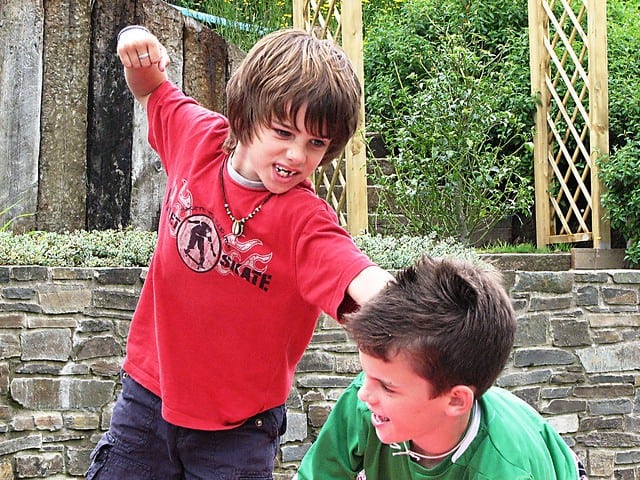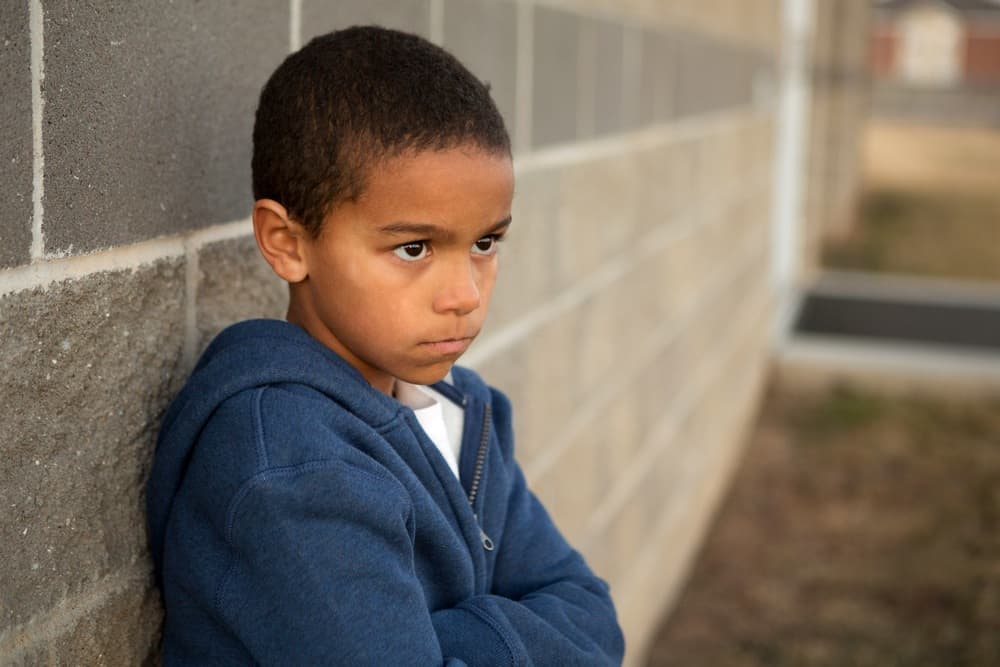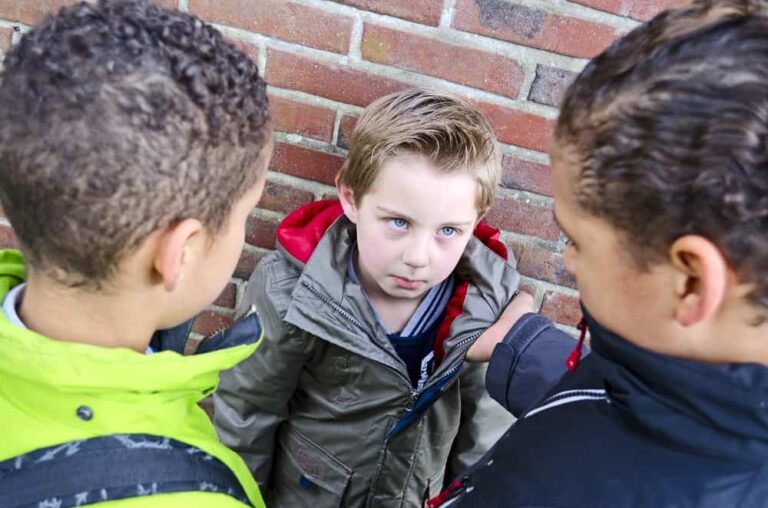As a family psychologist, I primarily treat adjustment issues, which bullying falls within. Many of my young clients have expressed that they have been bullied at school and online at one time. When I asked why they think they were bullied, several expressed that they thought it was because of the way they looked, acted, or talked.
Others thought it was because of their sexual orientation – they were bisexual, gay, and lesbian. Almost all of my young clients shared that at one time or another they felt lost, helpless, and suicidal. This alerted me to just how serious and lethal all forms of bullying can be. A movie called, Thirteen Reasons Why, became a cult phenomenon because it was based on a young girl, who committed suicide because of relentless bullying.
The sad reality is that this isn’t limited to movies — it also happens in real life. Children as young as age five are killing themselves because they don’t have the capacity to deal with bullies. We are losing children to hate, and it needs to stop now.
It starts with us, the parents. Our children learn how to behave, how to think, and how to respond to challenging situations from us. Therefore, we need to modify our behavior and pay attention to what is going on with our children.
We can stop this epidemic, but we must first look within.
The goal of this article is to talk about traditional bullying and cyberbullying, highlight the warning signs and effects of each, explain the differences between the two forms of harassment, and teach you ways to prevent or stop any form of bullying before it becomes out of control.
Table of Contents
- What is Bullying?
- Who Gets Bullied and Why?
- The Stats: How Often Does Bullying Occur?
- What Does Bullying Look Like?
- What is Cyberbullying?
- What are Warning Signs of Bullying & Cyberbullying?
- What Does Traditional Bullying & Cyberbullying Feel Like?
- Real-Life Example of Bullying
- Legal Implications
- How You Can Help
- What If You Are the One That’s Being Bullied? What Can You Do?
- Can Bullying Be Prevented? If So, How Can I Prevent It?
- What Should You Do If You Suspect That Your Child is a Bully?
- Who Can I Talk To?
- In Summary
What is Bullying?
Bullying involves committing the same hurtful, dangerous, mean-spirited, hateful, malicious acts over and over again, in an effort to intimidate, shame, degrade, dominate, and humiliate another person. [1]
We all know what traditional bullying looks like — attacking someone verbally or physically on a repeated basis. But, did you know there are other forms of bullying too? Bullying can come in all shapes and sizes, but it’s still just as damaging.
The truth is, any form of harassment from traditional bullying to cyberbullying can cause extreme emotional, physical, and psychological pain and distress.
Cyberbullying is fairly new, but it can cause anger, fear, shame, guilt, depression, anxiety, and low self-esteem/self-confidence in its victims, just like traditional bullying.
Some children even experience physical ailments, such as headaches or migraines, stomachaches, and high blood pressure due to bullying.
Many also struggle in school because their minds are focused more on the fear of being tormented by their bullies, rather than schoolwork. In other words, a child, who is being bullied is often unable to concentrate in class or on homework, because she is thinking about what will or what could happen to her once class is over.
If bullying behavior — whether in-person or online — does not stop, it can lead to a devastating outcome.
The good news is there are ways you can prevent or stop bullying. You may be able to save a child’s life simply by being proactive when you suspect or believe she is being bullied in any way.
Who Gets Bullied and Why?

Children, tweens, and teens are often the recipients of bullying (both in the real world and online), adults can also be bullied, especially with the explosion of social media. In a similar fashion, children, adolescents, and adults can also be bullies themselves.
As mentioned, cyberbullying, cyberstalking, and trolling fall under the umbrella of bullying. The goal of the bully is to force someone to submit to her. In other words, it’s a power move that arises for a variety of reasons.
For instance, some bullies mistreat other children because they are being abused or neglected at home. Others may bully so their peers will like, respect, and follow them. And some do it because they are jealous, have learned the behavior from others, or have some form of mental illness.
These are just some of the reasons a child or adult may turn into a bully. Regardless of the cause, the effects on the victim can be far-reaching, following her for the rest of her life.
Traditional bullying — also known as direct bullying, face-to-face bullying, schoolyard bullying, and in-person bullying — may involve physical, verbal, and/or emotional abuse. Cyberbullying, on the other hand, typically only involves verbal and emotional maltreatment — many times there is no direct contact.
However, sometimes, online harassment filters into the real world through school and other social activities, causing a child to experience all three forms of abuse online and in-person.
It is important to understand that most bullies enlist the help of their peers and classmates in the harassment of their victims. Moreover, bullying behaviors can occur at a number of places, some obvious and some less apparent.
For instance, bullying can occur on school buses, in class after the teacher steps away for a minute, in the parking lot or while waiting for parents or caregivers once school ends, while participating in after-school activities, between classes, at parties and social events, on the playground, at P.E., and/or at lunch.
It can even occur in the bathroom or library/study hall. And, of course, it can occur online — in online classrooms, on social media websites — like Facebook, Snapchat, Twitter, and Instagram, on Messenger, on dating websites, and even on gaming and interest websites.
The popularity and accessibility of social media, smartphones, messenger apps, etc. have caused bullying cases to skyrocket, particularly cyberbullying.
As a result, some states have enacted anti-bullying laws to deter bullies from abusing and mistreating others. The punishment for bullying in these states includes fines, counseling, removal from the home, and/or possible jail time.
The thing about bullies is that they are relentless. The torment never stops. So, a child who is being bullied lives in constant fear, because he never knows when his bully will strike next or how far he will take it.
The Stats: How Often Does Bullying Occur?

- 1 in 4 U.S. students have been, are, or will be bullied in school. More specifically, 28 percent of U.S. students in grades 6–12 have experienced or will experience bullying. And, 20 percent of U.S. students in grades 9–12 have experienced or will experience bullying. [13]
- Most cases of bullying occur during middle school with the most common types being verbal and social bullying.
- Young people who are perceived as “different” have the highest risk of being bullied.
- Bullying can affect all young people, including those who are bullied, those who bully others, and those who witness bullying. The effects of bullying can last well into adulthood.
- Approximately 71 percent of children and teens say they have witnessed bullying in their schools.
- When bystanders intervene, bullying stops within 10 seconds, more than half of the time.
- Approximately 9 percent of students in grades 6–12 have experienced cyberbullying.
- Approximately 15percent of high school students in grades 9–12 have been cyberbullied.
- Approximately 55 percent of LGBTQ students have experienced cyberbullying.
- In a recent study, approximately 49 percent of children in grades 4–12 reported being bullied by other students, whereas 31percent reported bullying others at one time.
- According to a recent study, middle school students experienced these types of bullying at this prevalence: name-calling (44 %), teasing (43 %), spreading rumors/lies (36%), pushing or shoving (32%), hitting, slapping, or kicking (29%);, exclusion (29%), threats (27%), stealing (27%), sexual comments or gestures (24%), and e-mail harassment (10%). [12]
- According to a recent study, middle school students experienced bullying in the classroom (29%), hallway or lockers (29%), cafeteria (23%), gym (20%), bathroom (12%), and playground (6%). [12]
What Does Bullying Look Like?

[1] Physical bullying typically involves:
- Hitting
- Kicking
- Pushing
- Injury
- Threat of Harm
- Stealing
- Property Damage
- Hazing
- Harassment
- Embarrassment and Humiliation

Verbal bullying typically involves:
- Making Fun of Another Individual
- Name-Calling
- Teasing
- “Roasting”
- Shaming
- Disparaging
- Criticizing
- Taunting
- Insulting

Lastly, emotional/psychological/social bullying typically includes:
- Shunning or Ignoring Someone and Refusing to Talk to Him
- Excluding Someone from Groups and Social Activities
- Spreading Lies or Starting False Rumors
- Forcing Someone to Do Things He Does Not Want to Do
- Turning Friends and Peers Against Another Person
FYI: Boys tend to use physical threats, intimidation, and violence to bully other boys, while girls tend to bully using emotional/psychological/social/relationship means to bully other girls. [10]
What is Cyberbullying?
It’s important to understand that cyberbullies, especially young children and teens, are creative and very imaginative.
They can find sneaky ways to bully others and go unnoticed, including sneaking on a home computer after hours to torment others, downloading apps onto their smartphones, pretending to do homework while really on social media sites, using email systems to send threatening, taunting, and hurtful messages, and even using other people’s computers, internet connections, and social media pages to humiliate and embarrass their victims. [2]
Cyberbullies also sometimes create fake websites or social media pages to harass their victims.
Similar to in-person bullying, you may be surprised to learn that boys and girls cyberbully in different ways.[10]
Male cyberbullies tend to use more physical means (actions) to torment their victims, while female cyberbullies tend to use more emotional means (feelings) to harass theirs. [10] It is also common for male cyberbullies to use sexting to hurt their ex-girlfriends, former lovers, etc. [10]
What is sexting? Sexting is sending someone sexual messages or private pictures — often nude and sexual in nature. Sexting becomes cyberbullying when those pictures are sent to other people or posted on websites in retaliation. The goal of sending these pictures to others is to shame and control the victim.
On the flip side, male cyberbullies tend to send threatening or intimidating messages to other males with intent of scaring their victims into submission. These messages typically contain threats of physical harm or death.[10]
Male bullies may start with cyberbullying and end with physical, in-person violence.[10]
Girl cyberbullies, on the other hand, tend to cyberbully through more emotional means like spreading rumors and lies, sharing their victims’ secrets with others, pointing out perceived deficiencies or flaws in their victims, preventing their victims from joining certain social media groups, blocking them from social media pages, and sending nasty, mean-spirited emails and texts.[10]
This form of cyberbullying rarely morphs into physical violence, although it can. [10]
Emotional cyberbullying can follow female victims throughout their lives, leading to low self-esteem, depression, anxiety, dysfunctional relationships, and possibly suicide. It is also important to understand that because it’s so easy to cyberbully others, often anonymously, it’s common for the victim to become the bully and the bully to become the victim.
Caution [2]
With the accessibility and popularity of social media sites, digital forums, smartphones, tablets, and online posts, it’s important to remind children and teens that their comments, photos, and everything they share online can be and often is viewed by many people — sometimes hundreds, thousands, or even millions of them. This possibly opens them up to mean, threatening, and hurtful responses and comments.
Parents, keep in mind that children under the “required” age, tend to lie on social media sites, when asked their age. More specifically, they tend to inflate their age to fit the age requirement by lying about when they were born. As a result, there are many, many underage children floating around on these sites as prime targets for pedophiles and hateful people. It is critical that parents keep a close eye on their children’s online activities.
Also, remind your children that what they say and do online is permanent. Even if they delete it, it’s still out there, regardless of if they can see it or not. If one searches hard enough, a record of past activities can be accessed.
What does that mean for your child? It means she could have a harder time getting into her chosen college or even landing her dream job because of something they posted 10-20 years ago. The truth is, cyberbullying hurts everyone in the long-run — both the victim and the bully.
How is Bullying Different from Cyberbullying?
Traditional bullying involves face-to-face, in-person, direct harassment and intimidation. Bullying, in the traditional sense, centers on physical actions; it involves threatening or doing something action-based to someone else. While cyberbullying typically remains in cyberspace or online.
Keep in mind, cyberbullying can turn into face-to-face bullying, or cyberbullying and traditional bullying can occur simultaneously. However, most of the time, cyberbullying stays online through text messages, social media comments, etc.
One can more easily identify the victim and bully in traditional bullying cases. Yet, it’s a lot harder to tell who the real bully and victim are in cyberspace. Why? Because everything is done online and the bully and victim can easily mask their true identities. Traditional bullies tend to be children and teens, while cyberbullies can be any age. [1,2]
Is Cyberbullying, Cyberstalking & Trolling the Same Thing?
While it is true that cyberstalking and trolling fall under the umbrella of cyberbullying, there is one key difference between cyberstalking and cyberbullying — age. For instance, cyberbullying that involves adults is usually coined cyberstalking, but cyberbullying that involves children and teens is usually labeled as cyberbullying.
Legally, however, there is no difference between cyberbullying and cyberstalking, other than age. Both forms of online harassment are treated the same in a court of law. Trolling, on the other hand, is not really schoolyard bullying or cyberbullying. The goal of internet “trolls” is to follow people they dislike or hate — usually celebrities — just so they can make hurtful, random, critical, controversial, and unsolicited comments on their social media pages.
People of all ages can be “trolls.” Trolling is usually short-term unlike cyberbullying and cyberstalking. Once the target posts something different, something happens to someone else, or the “troll” is ignored or blocked on social media, this form of online harassment usually ends.
“Trolls” simply want to get a reaction, any reaction, out of their targets, one that they hope leads to a nasty online fight, argument, or debate. These aggressors tend to get bored easily, so when the new “flavor of the month” pops up or when they don’t get the reaction they hoped for, they move on.
Also, keep in mind that a child or teen who is a victim of schoolyard bullying may become a cyberbully, primarily as a way to regain the power he is losing in the “real world.”
The unique quality of cyberbullying is that it is done anonymously, behind the safety of a computer screen. Most cyberbullies, cyberstalkers, and “trolls” have low self-esteem and self-confidence, have experienced trauma themselves, or have nothing better to do with their time than to harass others online. These individuals love having a veil between them and their victims. It makes them feel protected and invincible.
The truth is, cyberbullying, cyberstalking, and “trolling” are cowardly acts. Most cyberbullies are unlikely to harass others in “real life.” These individuals are often shy and timid people who become rude, aggressive, and threatening towards other drivers on the road — drivers they don’t know and probably can’t see clearly.
Or, those who appear to be nice, likable, and easy-going people at home and at work, but flip out when someone jumps them in line at the grocery store. These individuals act out of character and morph into ruthless and aggressive alter egos — egos that are usually hidden but spring into action when slighted or peeved because there is a degree of anonymity. [6]
What are Warning Signs of Bullying & Cyberbullying?

Contrary to popular belief, bullying in any form just doesn’t pop up overnight. Rather, in most cases, it’s a slow simmer peaking once the harassment becomes overwhelming, and possibly dangerous. Also, keep in mind that children don’t just have to be a bully or victim — they can also witness bullying and be deeply affected by it.
It’s important for parents to pay close attention to how much time a child spends online. Make time to look at your child’s smartphone usage, how much time he spends on social media pages like Facebook, Snapchat, Instagram, Tumblr, and Twitter, the apps he has downloaded on his tablet (Kindle or iPad) and/or on his smartphone, and whether or not he is interacting on dating websites.
Also, pay attention to how your child behaves before and after school, and how much time he spends alone in his room. Keep a watch on your child’s behavior and emotions.
- Has there been a change in your child’s demeanor and behavior?
- Is he suddenly depressed, angry, teary, and/or anxious?
- Does he shy away from social functions or resist going to school?
- Does your child appear fearful much of the time, but will not tell you why?
- Does your child come home sad after school, afterschool activities, and/or social events?
- Has he withdrawn from family and friends?
- Does your child appear to be suicidal or does he engage in self-harm behavior?
If the answer is “YES” to any of the questions above, your child may be the victim of bullying, traditional or cyber-based.
The more digital platforms your child has access to, the easier it is for bullies to harass her online.
Note: Most children and teens spend a massive amount of time on their devices, so it’s sometimes hard to determine if they are spending more or less time on them. The best thing to do in this situation is put limits on how much time your child spends on their devices.
Allow a set amount of hours on certain days for digital fun time. The new “kid-friendly” Kindles allow parents to control how much time their children spend on the tablet and what they see while using it. This may be a good option for young children and tweens.
You can also sit with your child when he uses a device. This way you can see what he is looking at. Once your child is finished with the device, go through the browsing history to see what he has been looking at online. [4,5]
Physical Signs of Bullying
- Has unexplained cuts, bruises, scratches, and/or wounds
- Comes home from school and social events with missing or damaged clothes, books, devices, jewelry, or other belongings
- Is always starving when he comes home from school, even though you packed him a lunch or provided him with lunch money
Emotional & Behavioral Signs of Bullying
- Experiences changes in sleep patterns, i.e., has a hard time falling and staying asleep
- Experiences changes in eating patterns, i.e., skips meals or binge eats
- Complains of feeling sick in the mornings with headaches and/or stomachaches
- Feigns illness to get out of going to school
- Suddenly loses a noticeable amount of friends
- Has begun to “stammer”
- Is often aggressive, difficult to deal with, temperamental, “extra” and/or extreme
- Refuses to tell you what is wrong
- Targets and/or bosses around siblings for no apparent reason
- Constantly misplaces his lunch money or the money he makes from an afterschool job
- Experiences frequent mood swings, and/or has lost interest in people and activities he used to love
- Avoids social events, even if he loved socializing in the past
- Engages in self-destructive behaviors, i.e., running away from home, self-harm, cyberbullying, and/or suicide thoughts or attempts
Signs of Bullying at School
- Avoids or complains about going to school
- Asks you to take or pick him up from school instead of riding the bus or walking home
- Appears to be afraid of going to school or being alone
- Experiences a decline in grades
- Tends to spend most of his time at school alone (i.e., at lunch)
- Is excluded from social groups at school
- Is frequently teased, ridiculed, taunted, and mimicked at school
- Rarely speaks in class due to a lack of self-esteem or self-confidence
Signs of Cyberbullying
- Suddenly and noticeably “ramps up” or “slows down” his device usage, including texting and spending time online
- Deactivates his social media pages and gives you a vague or non-existent answer when you ask why
- Becomes overly emotional (distressed, anxious, animated, fearful, sad, angry, aggressive, etc.) while looking on his electronic devices
- Hides the screen when you or others come around
- Refuses to tell you what he is looking at or doing on his device when you ask
- Repeatedly shuts down old social media pages, only to open up new ones
Signs That Your Child Is the Bully
- Frequently gets into physical altercations and/or verbal fights, in-person or online
- Spends time with other bullies and calls them friends
- Has become increasingly aggressive, disrespectful, and angry
- Is repeatedly sent to the principal’s office or detention
- Always has extra money and new items, even though he is not working and you didn’t provide the items
- Tends to blame others for their mistakes and problems
- Hardly ever accepts responsibility for his actions
- Is extremely competitive and tends to overly focus on reputation and/or popularity
What Does Traditional Bullying & Cyberbullying Feel Like?

Many of my child clients have described traditional bullying as “constant fear and terror,” “loneliness,” “embarrassment and humiliation,” “having to constantly watch one’s back,” “a loss of friends,” “being disliked, ridiculed, and laughed at on a daily basis,” “getting pushed, kicked, spit on, and beat up on a regular basis,” and “not feeling like you can tell anyone what’s really happening.”
They tell me that the only good thing about this form of bullying over cyberbullying is that you get to hide at home, but sometimes the bullying enters cyberspace, so you are bullied at school and at home. Then, your home isn’t even safe. Traditional bullying is physical, which adds another level of fear to the mix. The target never knows if he is safe, so he always has a heightened level of alertness.
Cyberbullying, on the other hand, is online, which means it can happen at any time and in any location. All that is needed is a digital device and internet service. As a result, your child could be being bullied in your home, right under your nose.
It could even happen while you are sitting next to her on the couch or while she is sitting in a public place with lost of people close by. Cyberbullying can feel like the harassment, taunting, and humiliation is never-ending.
To top it off, cyberbullies are anonymous, so it’s almost impossible to prove who is actually doing the bullying. Your child may suspect a particular person or group of people, but, unless the bully does something illegal and the police are able to obtain a court order for the contact information attached to a certain phone number or social media account, the bully remains protected.
As a result, these bullies feel powerful, because they can say and do what they want without consequence. And, because cyberbullies are unable to see your child’s response to their posts, texts, and messages, they often take the harassment and taunting a step further than they would if your child was standing in front of them.
The feelings associated with cyberbullying can have long-reaching and long-lasting effects on the victim. For instance, this form of bullying — through social media posts, text messages, and emails — is sent and resent to many, many people. It can be witnessed by loved ones, friends, romantic interests, teachers, and strangers — thousands, if not millions of them.
In some cases, cyberbullying can even go viral and become a sensation, despite your child’s feelings and desire for dignity. The more people, who see the embarrassing and hurtful posts and messages, the deeper the wound.
Other “feelings” associated with bullying include: [7]
- Feeling Overwhelmed
Being targeted by bullies, regardless of the form, is devastating. This is especially true if there are several bullies, instead of just one. Your child most likely feels like everyone is against him and that no one likes or loves him. He may also feel like everyone is laughing at and criticizing her. Therefore, children who are chronically bullied can become so overwhelmed by it that they contemplate or attempt suicide as an escape from the torment.
- Feeling Helpless, Exposed & Powerless
Children who are bullied often feel helpless, exposed, and powerless. In other words, they have a hard time feeling safe at home, at school, or in public. Remember, bullying can include both types of harassment, cyber and traditional bullying. Therefore, your child most likely feels like there is nowhere to hide or escape from the humiliation. And, if he has a cyberbully, but isn’t sure who it is or can’t prove who it is, the fear escalates.
- Feeling Hurt, Isolated, Angry & Ashamed
When bullying occurs in front of other people — online or face-to-face — it can cause the victim to feel hurt, isolated, angry, and ashamed. This is especially true if friends and peers of the victim join in or laugh at the taunting. These children feel like they have no friends, essentially no one to have their backs.
As a result, they tend to become embarrassed and infuriated and isolate themselves from others as a way to avoid the emotional pain of not having any support. Your child’s probably still feels guilty, even though the harassment is not their fault. He becomes ashamed, which adds to the pain and embarrassment. Keep in mind that stress that comes from being bullied on a regular basis can prevent your child from being truly happy and content.
- Feeling Unhappy About Her Appearance
Bullies typically attack their victims where they know it will hurt the most. They also tend to target children with low self-esteem/self-confidence. As a result, victims of bullying tend to doubt their self-worth and value. They may respond to these feelings by harming themselves in some way.
For example, one of my child clients was relentlessly teased and called “ugly” and “bunny rabbit” by peers because of her protruding teeth. She became extremely self-conscious and embarrassed about her teeth, so she begged her parents to get braces, even though they couldn’t afford them at the time.
As a result, this young, 8-year-old girl took a bottle of pills, attempting suicide as a way to escape the taunting of her peers. Many times, a victim of bullying will try to alter her appearance to get others to like him better. In the mind of a child, if she looks different, all the “bad stuff” will go away.
- Feeling Disinterested
When a child is constantly being bullied, he views the world and the people in it differently than those who are not being harassed. In fact, for many victims, life can feel bleak and empty. As a result, these children tend to lose interest in things they once enjoyed — like spending time with friends and family, excelling in academics and/or sports, etc.
It is common for these children to feel like nothing matters anymore, including their own lives. If you suspect your child is suicidal, take her to a therapist or the nearest emergency room for an evaluation right away.
It is important to note that victims of bullying often skip or miss school more often than those who are not bullied. These children miss school as a way to avoid bullies or because they are embarrassed about what is being posted about them online or said about them in between classes.
As a result, they are unable to concentrate on classroom tasks and homework assignments. These children become consumed with the bullying, leading to high levels of stress, anxiety, and depression. Then, their grades decline and many either drop out of school or refuse to go to college once they graduate from high school. Your child may feel that he is less likely to experience bullying, if he no longer attends school.
- Feeling Sick
Children who are bullied tend to complain that they feel sick — complaining of headaches and migraines, muscle aches, stomachaches, and/or other ailments. The truth is, being bullied is stressful and high stress levels can lead to conditions such as gastrointestinal distress, stomach ulcers, headaches, muscle pain, and even skin rashes and acne.
In addition, your child may lose his appetite and not want to eat much due to the bullying. He may also not feel like sleeping or may awaken many times throughout the night. Racing thoughts and nightmares about the bullying may prevent her from sleeping soundly.
If your child complains that he does not feel well, he probably doesn’t. The stress of bullying can affect a person’s health, increasing his risk of developing physical ailments like high blood pressure and psychological conditions, such as depression, low self-confidence/self-esteem, anxiety, and PTSD.
- Feeling Suicidal
As mentioned, studies suggest that victims of bullying have an increased risk of suicide. [11]
Why? Primarily because the onslaught of negativity from peers and strangers (in-person and online) can cause them to feel hopeless and vulnerable,[11] desperate for the emotional and/or physical pain to stop, so these children tend to turn towards suicide.[11]
Many children, especially the most vulnerable, fantasize about ending their lives to escape their bullies.[11]
Therefore, it is imperative that you take your child’s concerns seriously, especially if he tells you that he doesn’t feel like living anymore.[11]
Never dismiss or ignore your child’s feelings. And, play close attention to any changes in your child’s mood or behavior. If you believe your child is thinking about or planning to take his own life, take her to the nearest emergency room immediately.
Real-Life Example of Bullying
Note: Names and some details have been changed to protect identities.
“It all started online when one of my classmates, another female, took a screenshot of my Facebook post. On the post, I talked about my love of singing. She then took the screenshot and posted it on her Facebook page. On her post, she called me horrible names and wrote that I couldn’t sing. I had always wanted to be a professional singer.
It hurt me really bad and it made me cry. But, she pretty much left me alone until we both ended up at the same camp during the summer. I mustered up the courage and asked her about the post. She told me it wasn’t her that she had lost her phone, which was a boldface lie. After camp was over, she began harassing me again — this time at school and online.
She and her friends verbally bullied me, which caused me to have severe anxiety. Then, one day, she pushed me into the locker, as I was walking to class. The push caused my glasses to go flying and then her and her friends laughed at me and stepped on my glasses.
I couldn’t see, but a friend helped me to the guidance office. I didn’t report it. I just told the counselor I fell on my glasses. A few weeks later, my bully stole my lunch and ate it in front of me. My anxiety and depression worsened, and I had a hard time sleeping and eating. I lost a ton of weight and I cried all of the time. It lasted a year.
Once I started having panic attacks, my parents began homeschooling me. I still have panic attacks to this day even though the bullying happened 20 years ago. I’m an adult now, but I can still feel the effects of the bullying.”
~Beth, age 13 at the time of bullying, now 33
Legal Implications
Most, if not all states have laws that require educators to report bullying. However, almost no school districts in the U.S. require those same educators to report cyberbullying, because it usually occurs off-site.
In other words, it does not happen on school grounds, so it’s the responsibility of the parents to handle this kind of harassment. In actuality, there are no rules or guidelines on how to respond to cases of cyberbullying, off or on school grounds.
While traditional bullying is well-defined in the law, the legal implications of cyberbullying are vague and unclear, primarily because it occurs in cyberspace and the aggressors are typically anonymous. However, with traditional bullying, administrators can either discipline, suspend, or expel the bullies.
Regardless, educators must report traditional bullying activities to the proper authorities — i.e., Child Services and/or the police. It is important to note that some states do have policies to address cyberbullying if it causes a decline in the victim’s grades. [8,9]
You can learn more about local school bullying polices on your Board of Education website.
How You Can Help

First, it is important to never punish or ridicule a child who is being bullied in-person or online. It’s also imperative that you not limit your child’s freedom. What you can do is monitor what your child is looking at on the internet and the length of time he stays online.
Also, pay close attention to how much time he spends on his smartphone and tablet. Any digital device places your child at risk for traditional and cyberbullying.
Note: Your child may become angry with you and resent that you are checking up on him, but don’t allow that to deter you. Your child will get over it and you will be thankful that you kept him safe. The good news is there are ways you can help your child combat bullies. The key is to be vigilant and proactive.
How you can help your child cope with bullying:
- Use the parental control functions on your child’s smartphone or tablet to filter and limit what he sees on the web and how much time he spends on it. Don’t feel guilty about blocking inappropriate content on the web, and never feel bad about monitoring your child’s online activities. Remember, bullies aren’t the only things lurking on the web — there are also sexual predators and criminals, including sex traffickers who are eager to prey on impressionable children and teens.
- Restrict the amount of data (internet access) on your child’s smartphone. Some internet providers allow you to turn off texting during certain hours.
- Don’t be passive. Demand that your child give you all of his passwords.
- Learn common internet acronyms (LOL, LMAO, etc.) and slang (“ship”). Kids nowadays use a wide range of code words so their parents don’t know what they are doing and saying. Knowing these acronyms and phrases will help you decipher what your child is saying to others.
- Know who your child is talking to online and in real life. Ask to meet or chat with your child’s real-life and social media friends. Periodically, look over your child’s smartphone and tablet contact list and check out any addresses of friends before you allow your child to spend time at their residences.
Note: This means physically traveling to the friend’s home and meeting her parents before allowing your child to go to the home. Ask your child details about each person — i.e., name, location, state, age, hair color, race, hair type, height, weight, eye color, and any other distinguishable traits.
- Tell your child the truth. Review the “Stranger Danger” concept with your child, including child trafficking, and describe grooming practices to him. It is better that your child knows the pitfalls and traps so she can avoid those situations.
- Encourage your child to tell you or another adult if he is being bullied. It doesn’t matter if your child receives threats online or through digital or physical messages, reassure him that none of this is her fault and let her know you are always available to listen and help.
- Get to know your child better. Spend time with your child. Learn what your child likes and dislikes and try to develop a safe and acceptable relationship. It is possible that your child’s friends are encouraging her to bully other children, instead of vice-versa. The more you know about your child’s life, the easier it will be to recognize and address any problems.
- Teach your child about bullying — what it is and how it starts. Also, explain what to do if he is the target of bullying or if he is the bully. Talk about how hurtful bullying is and teach him ways to cope with it.
- Help your child manage stress. Specifically teach your child how to positively cope with bully-based stress: exercise with your child, spend time together observing the beauty and stillness of nature, do things your child likes to do, engage in hobbies that your child is interested in, take your pet to the park together for playtime and walks, watch your favorite sitcoms and/or movies together, play games like UNO, etc. This will help you and your child blow-off steam while bonding and having fun.
- Set specific behavior guidelines. Make sure your child fully understands what you expect of him at home and at school. It is common for children to believe they don’t need supervision, guidelines, rules or anything else, but they do. Children need boundaries to develop and thrive. When a parent doesn’t provide those boundaries for a child, it increases the risk of him becoming a bully or engaging in dangerous and unhealthy behavior.
What If You Are the One That’s Being Bullied? What Can You Do?
While there is no foul-proof way to cope with bullying, traditional or cyber, there are ways you can manage the stress and hurt feelings associated with bullying. Bullying normally occurs over time, so one of the best things you can do to combat this harassment is report it to anyone and everyone each and every time.
Don’t brush it off — report it to your parents, teachers, and other adults in your life, and report it to the police. They may be able to monitor the situation so it doesn’t escalate further. The police may even be able to stop the bullying altogether. Remember, you don’t deserve to be treated this way. You are valuable and loved, so don’t allow a bully to treat you any less.
Other ways to cope with bullies include:
- Don’t blame yourself
This is not your fault. Regardless of what your bully tells you and others, you did nothing to deserve to be tormented and harassed. Do not allow anyone to make you feel ashamed of yourself for how you look, any disabilities, your personality, etc. The bully is the problem, not you!
- Try to look at the situation in a different way
The truth is, a bully only harasses and torments others because she is unhappy. Maybe, she is being bullied at home by siblings or parents. Or, maybe the bully is angry about something she cannot control, so she takes that anger and frustration out on you. Regardless of the reason, your bully is miserable. And, because she is miserable, she wants you to feel as bad, if not worse. Don’t give your bully that power.
- Don’t obsess about it
The worst thing you can do is obsess or dwell on the bullying. When you do that, you give your bully power over you. The worst thing for a bully is to not get any reaction out of you. So, stop reading over the nasty text messages, social media posts, emails, etc. and stop thinking about what your bully said and did to you.
Do the opposite and ignore her. Your non-response will absolutely bore her, causing her to find another target. Save the messages in a separate location, so you’ll have proof of the harassment should it escalate, and then delete them off your phone, tablet, etc. Block your agitator online and on your phone. And, focus on the people who really matter ,like your family and close friends. And, most of all, believe in yourself, because you’re worth it.
- Learn stress management and relaxation techniques
If you want to deal with a bully situation in a positive and healthy way, you need to learn how to calm yourself down when you’re frustrated and upset. How do you that? By learning stress management and relaxation techniques — learning healthy ways to ease your tension and reduce stress can help you better handle this situation.
If you can relax your body and find inner peace, no matter what your bully fires at you, it will simply bounce off. Common stress management and relaxation techniques include: exercising, engaging in positive self-talk, meditating, learning how to relax your muscles, deep breathing, massages, reading, writing, etc.
- Unplug
If you want to lower your stress level and manage the bullying, you need to unplug, especially if your tormentor is online. Try to meet new, positive people who appreciate you just the way you are. Look for people who share your interests. They are out there, trust me. You just have to put down your device and get out there and find them.
- Volunteer
Helping others is great way to boost your self-esteem and self-confidence, and make you feel happy and valuable. There’s nothing better than helping others in need. It’s also a great way to include more positive people into your inner circle, people who will have your back against your bully.
- Talk about it
Keeping the bullying bottled up inside will only make things worse, so don’t do that! Talk to your parents, teachers, friends, siblings, coach, counselor, pastor, or anyone else who will listen. Use your voice, because it could put an end to the bullying altogether.
If you don’t feel comfortable verbally expressing what is happening and how it makes you feel, write it down and give it to someone you trust. Your confidant may have some really great ideas on how to handle the bullying and what to do next.
- Report it
You should always report bullying, regardless of if it is online or in real life. You should also report bullying if you witness it happening to someone else. Never tolerate this type of behavior. If someone threatens to send private sexual text messages or pictures to others, report it to the police. That is illegal. In this situation, cyberbullies can be prosecuted.
- Seek counseling
If you are grappling with harassment, seek counseling. Many times, children are afraid of counselors because they think seeking professional help signifies that they have a mental illness. That is not the case. Counselors are simply there to help you process and cope with issues in your life.
They are there to listen, which is probably what you need most right now. They are also there to teach you how to deal with adversity in a healthy way and to help you find solutions to your problems. You will never receive judgement from a counselor, because that’s not their job. They are only there to help you. If you need help, ask for it!
Can Bullying Be Prevented? If So, How Can I Prevent It?
Yes, it can! One of the best ways to combat bullying is to stop it before it starts. How? Try the following:
- Refuse to pass along messages from the bully to her target
- Tell your friends to STOP bullying others
- Block bullies on social media and delete their messages without reading them
- Don’t post or share a target’s personal info online or start false rumors
- Don’t share your social media passwords with anyone, except your parents
- Tell your parents what you are doing and who you are talking to, online and in-person
- Don’t post anything online that you wouldn’t want your family, friends, pastor, crush, classmates, etc. to see
- Don’t send hateful messages to others, even while upset or angry
- Refrain from getting into heated arguments with others, in-person or online
- Always be respectful towards others
What Should You Do If You Suspect That Your Child is a Bully?
It can be difficult to hear that your child is the bully, but there are ways to steer your child back onto the right path. It is imperative that you address the misbehavior before it causes irreparable emotional and physical damage to his victim. Keep in mind that your child watches how you behave in certain situations — if you exhibit bully behaviors, he will most likely do the same.
The first thing you need to do is evaluate and modify your own behavior, then your child will follow suit. Moreover, if your child is having a hard time managing his emotions, talk to a therapist. The therapist will be able to teach your child how to cope with any negative emotions — i.e. anger, frustration, hostility, etc. — in a positive way.
Lastly, ask your child why he feels the need to bully others. Ask him to describe to you how it probably makes the other person feel. The key to stopping this negative behavior is determining the cause of it. Once you know why your child feels the need to put others down, you can take steps to stop it.
Who Can I Talk To?
If you or someone you know is experiencing bullying or cyberbullying or feeling suicidal, please call 1-800-273-8255 in the U.S., or visit IASP or suicide.org to find a help in your area.
In Summary
Bullying, in any form, can have long-lasting and detrimental effects on the victim. It can also lead to emotional, physical, social, and psychological conditions, many of which follow the victim into adulthood.
There are many reasons why a child becomes a bully, but, regardless of the reason, it doesn’t give hher permission to torment others. It’s hurtful and damaging, but it can be stopped. If everyone who witnesses or experiences bullying reports it, new laws will be enacted, and those who bully will be punished.
If there are consequences to the behavior, children will be less likely to engage in it. The key is to be mindful and proactive when it comes to our children. Listen to them, get to know them, and protect them from aggressors by paying attention to them and monitoring their activities.
Our kids need us! No child should ever feel like there is no way out but through death. Children need to be taught how to effectively combat relentless bullies — in the schoolyard and in cyberspace.
References:
- American Psychological Association. (2019). Bullying. Retrieved from https://www.apa.org/topics/bullying/
- Kids Health. (2019). Cyberbullying. Retrieved from https://kidshealth.org/en/parents/cyberbullying.html
- Stopbullying.gov. (2019). Warning signs for bullying. Retrieved from https://www.stopbullying.gov/at-risk/warning-signs/index.html
- National Centre for Bullying. (2019). Signs of bullying. Retrieved from https://www.ncab.org.au/bullying-advice/bullying-for-parents/signs-of-bullying/
- Cyber stalking Research Center. (2019). Cyber stalking. Retrieved from https://cyberbullying.org/cyberstalking
- Alexander, R. & Krans, B. (2016). Anxiety, depression, and suicide: The lasting effects of bullying. Healthline. Retrieved from https://www.healthline.com/health-news/bullying-affects-victims-and-bullies-into-adulthood-022013
- Hinduja, S. & Patchin, J. W. (2015). Cyberbullying legislation and case law. Cyberbullying.org. Retrieved from https://cyberbullying.org/cyberbullying-legal-issues.pdf
- Stopbullying.gov. (2019). Laws, policies & regulations. Retrieved from https://www.stopbullying.gov/laws/index.html
- Gordon, S. (2018). Do girls and boys bully differently? Very Well Family. Retrieved from https://www.verywellfamily.com/do-girls-and-boys-bully-differently-460494
- Holt, M. K., Vivolo-Kantor, A. M., Polanin, J. R., Holland, K. M., DeGue, S., Matjasko, J. L., Wolfe, M., & Reid, G. (2015). Bullying and suicidal ideation and behaviors: a meta-analysis. Pediatrics, 135(2), e496-509. Retrieved from https://www.ncbi.nlm.nih.gov/pmc/articles/PMC4702491/
- Bradshaw, C.P., Sawyer, A.L., & O’Brennan, L.M. (2007). Bullying and peer victimization at school: Perceptual differences between students and school staff. School Psychology Review, 36(3), 361-382.
- National Center for Education Statistics and Bureau of Justice Statistics. (2011). Student reports of bullying and cyber-bullying: Results from the 2011 school crime supplement to the National Crime Victimization Survey. Retrieved from https://nces.ed.gov/pubs2013/2013329.pdf


